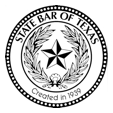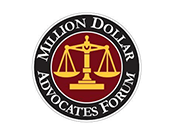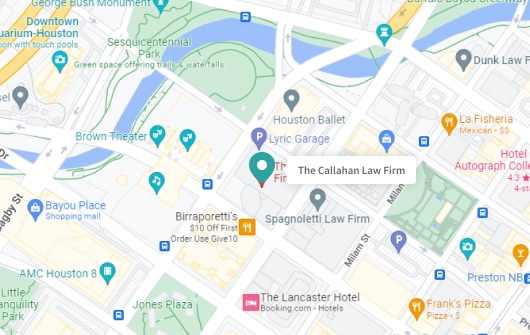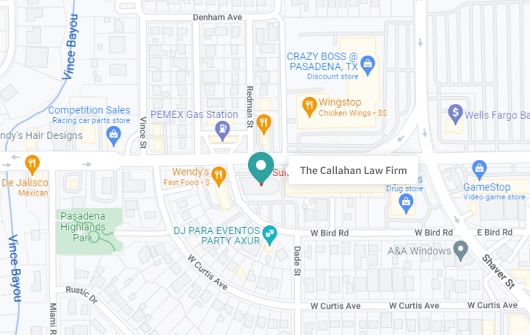Houston Speeding Car Accidents
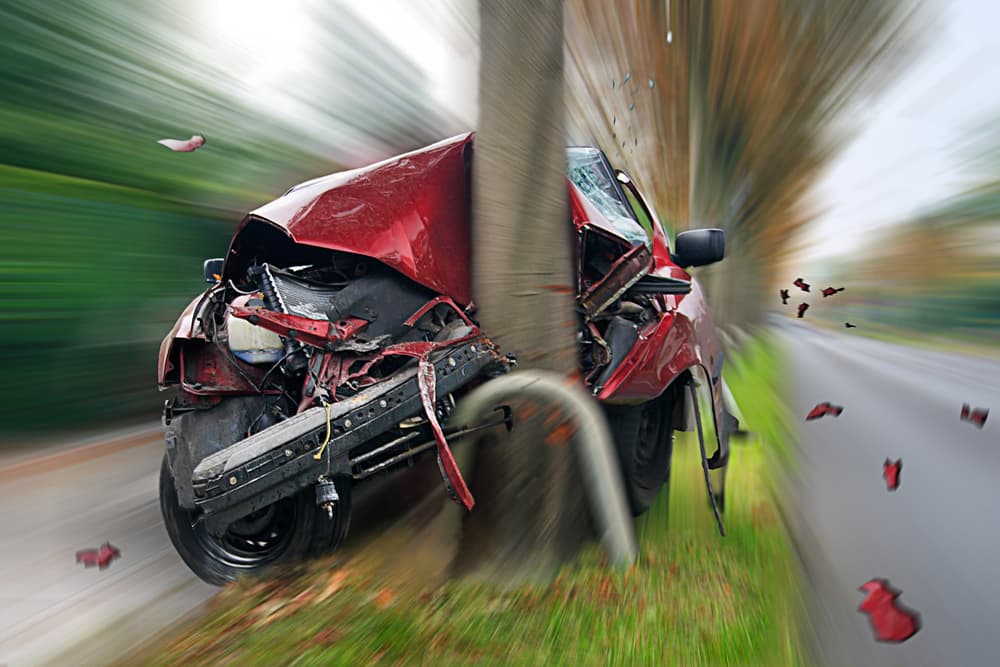
Did a speeding driver hit you in Houston? If you suffered severe injuries, lost income, pain and suffering, and other losses, you could be eligible to pursue a personal injury claim against the at-fault driver. As all motorists know, speeding is against the law. You could seek fair compensation and justice when a driver breaks the law and injures you.
The Houston attorneys at The Callahan Law Firm know that getting justice doesn’t come easy. But we’ve built a solid reputation for aggressive and effective representation through our 25+ years of serving the Houston community. Let us put our skills and experience to work for you.
Contact us today for a free, no-risk consultation and legal advice about your best options for seeking compensation after a crash caused by a speeder in Houston.
How Speeding Causes Car Accidents in Houston
Speeding contributes to car accidents across the Houston metro area in the following ways:
- Speeding increases the likelihood of a driver losing control of their vehicle. Drivers who speed may be more likely to swerve into approaching cars or guardrails. That can result in deadly rollover accidents.
- Speeding reduces reaction time. A driver traveling at high speeds may not react in time to prevent an accident if traffic suddenly slows or stops or other traffic hazards arise. Drivers traveling at high speeds require more time and distance to stop safely.
- Certain safety features may malfunction at high speeds. Safety features, including airbags and seatbelts, may function if a driver crashes into another motorist at high speed. These features are designed to protect motorists and their passengers from the force of a collision. If they fail to function properly, severe or fatal injuries could occur.
Even if speeding was not the main cause of a crash, excessive speed could amplify the severity of any injuries victims sustain in an accident.
Texas Laws Regarding Speeding
Section 545.351 of the Texas Transportation Code states drivers “may not drive at a speed greater than is reasonable and prudent under the circumstances then existing.” In other words, motorists must maintain a safe speed for road conditions, traffic, weather, and other factors. Motorists may need to adjust their speed depending on the conditions.
Drivers are also required to reduce their speed:
- When approaching intersections
- Driving along a curve on the road
- Approaching the top of a hill
- Driving on a thin or winding road
- When hazardous conditions are present, such as inclement weather
Dangers of Speeding Car Accidents
According to the National Highway Traffic Safety Administration (NHTSA), speeding caused 12,330 traffic fatalities in 2021. Speeding is dangerous for many reasons. Perhaps the most consequential reason is that speeding crashes are more likely to result in severe or even fatal injuries.
Some of the common types of injuries sustained in speeding car accidents include:
- Traumatic brain injuries (TBIs) and concussions
- Neck and back injuries
- Spinal cord injuries
- Paralysis
- Disfigurement
- Whiplash
- Burns
- Joint damage
- Cuts, scrapes, and lacerations
- Broken or fractured bones
- Internal injuries, such as ruptured kidneys and punctured lungs
Driving too fast for conditions, though under the speed limit, is another type of speeding. Motorists are more likely to cause an accident when they go too fast in inclement weather conditions or on hazardous stretches of road.
For example, drivers who speed in the rain can hydroplane, causing them to lose control of their vehicle. Likewise, speeding through road construction zones or in heavy traffic can result in a crash.
Drivers who speed are also more likely to engage in other dangerous driving behaviors, such as tailgating and reckless or aggressive driving. Drivers who engage in this type of behavior put themselves, passengers, and other motorists at significant risk.
Types of Accidents Caused by Speeding
Speeding was a factor in 29% of all traffic fatalities in 2021, and it contributes to many types of accidents, including:
Rear-end collisions
When a vehicle travels at high speed, it may not be able to stop in time to avoid crashing into the vehicle in front. This often happens when the lead vehicle suddenly slows down or stops.
Loss of vehicle control
Speeding reduces the driver’s ability to control the vehicle, especially during inclement weather. It increases the risk of skidding or hydroplaning, resulting in loss of control and potential collisions.
Head-on collisions
Excessive speed significantly raises the chances of head-on collisions. When drivers travel at high speeds, there is less time to react and correct their course if they drift into oncoming traffic.
Running off the road
Speeding makes it more difficult to stay within the designated lanes. Drivers may lose control, veer off the road, and collide with obstacles such as trees, guardrails, or ditches.
Pedestrian and bicyclist accidents
Speeding vehicles require longer stopping distances. When drivers exceed the speed limit in areas with pedestrians or bicyclists, they have less time to react if someone unexpectedly enters the road, increasing the likelihood of accidents and severe injuries.
Increased severity of injuries
Speeding raises the likelihood of accidents and increases the severity of injuries sustained in them. The higher the speed at the time of impact, the greater the force exerted on the occupants, resulting in more severe injuries.
Financial Recovery Following Speeding Accidents
If you were injured in an accident caused by a speeding driver, you might be eligible to claim compensation. Compensation is designed to cover expenses and other losses resulting from an accident. Depending on the circumstances of your case, you might be able to recover compensation for losses such as:
- Medical expenses – If you were injured in a crash, you could recover compensation for present and future medical costs related to the accident. Medical expenses may include hospital bills, doctor’s fees, surgery costs, prescription medication expenses, rehabilitative care costs, and more.
- Lost wages – Depending on the severity of your injuries, you might not be able to return to work directly after the accident. As medical bills pile up, losing your income can put even more financial strain on your household. If you can’t work while recovering, you could claim compensation for lost wages.
- Lost earning capacity – Job performance and capability could suffer if you suffered injuries that left you temporarily or permanently disabled after the accident. In that case, you could claim compensation for lost earning potential.
- Pain and suffering – Through a personal injury lawsuit, you could also seek compensation for non-financial losses like pain and suffering, including physical pain, emotional distress, mental anguish, loss of enjoyment of life, and post-traumatic stress disorder (PTSD).
- Property Damage – If your vehicle was damaged in the accident, you could seek compensation for repairs or replacements.
- Exemplary damages – In some cases, you might obtain exemplary damages, also known as punitive damages. Juries typically award them only in cases of extreme recklessness or gross negligence. The purpose of punitive damages is to punish the at-fault driver for egregious conduct.
How to Deal With Speeding Drivers
It is impossible to foretell an accident, but it is possible to take precautions and always be alert on the road to avoid one. If you encounter speeding drivers, here are some tips for dealing with the situation:
- Stay calm: It’s important to remain calm, don’t let their behavior provoke you.
- Maintain a safe distance: This will give you time to react if they make sudden maneuvers.
- Avoid confrontation: Do not confront the speeding driver.
- Do not block or impede: Avoid blocking them or intentionally impeding their progress.
- Report to authorities: If you feel threatened or observe extremely dangerous behavior, note the license plate number, make, model, and vehicle color.
- Focus on defensive driving: Concentrate on your own driving and practice defensive driving techniques.
- Choose safer routes: Consider alternative routes if you frequently encounter speeding drivers on a particular road or highway.
Can a Speeder Be at Fault Even If They Don’t Get a Ticket?
Traffic violations such as speeding tickets are separate matters from civil liability for a crash. Just because a speeding driver didn’t get a citation or accepted defensive driving on speeding charges doesn’t mean they are not at fault for the accident. If the other motorist caused the accident, they could be held liable for losses resulting from the crash.
What to do if involved in an accident
If you’re involved in an accident with a speeding driver, here’s what you must do:
- Stop in a safe spot
- Call 911
- Seek medical attention
- Collect evidence of the accident
- Get the contact details of any witnesses who saw what happened
- Contact the insurance company
- Call a personal injury claims lawyer
Contact Our Experienced Houston Speeding Car Accident Attorneys Today
If you were injured in a speeding accident in Houston, contact The Callahan Law Firm’s car accident attorneys. We have the necessary skills and resources to help you pursue the compensation you deserve. Reach out today for a free, no-risk consultation.



